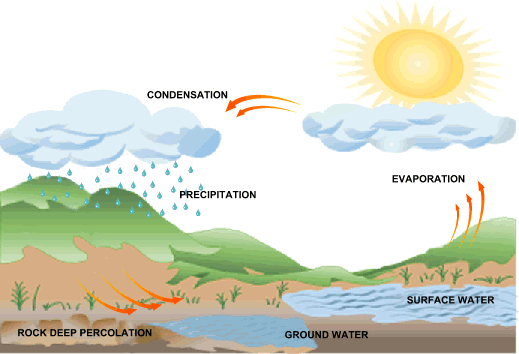

It is not only liquid water that can evaporate to become water vapor, but ice and snow, too. Sublimation – as the process is called, results from when pressure and humidity are low as noted above.The majority of water in the atmosphere comes from lakes and oceans – around ninety per cent – but in terms of land-based water, evapotranspiration is an important player. Evapotranspiration – makes up a large portion of the water in the planet’s atmosphere due to the sheer surface area of the globe covered by flora.Evaporation – is frequently used as a catch-all term to refer to the process of water turning to water vapor, however there is another distinct term for the evaporation of water from a plant’s leaves.Here is a breakdown of the different steps of the hydrologic cycle. See also Green Architecture: Materials Used and Principles of Green Architecture Different Steps of the Hydrologic Cycle This simple explanation, however, does not do justice to the complexity of the hydrologic cycle, which comprises many more steps. This process is simple enough, however there are a few things to note about evaporation. However, places such as mountains, where humidity is low and pressure is even lower, require less energy to boil away the water.Īlong with the water vapor, some small particles can often rise up to form clouds. Typically, we consider the boiling point of water to be a hundred degrees centigrade, which is certainly true when pressure and humidity are normal. The water vapor, thus becoming less dense, rises with the warm air into the sky where it sticks to other water particles to form clouds. The sun’s rays constantly warm the water found in these places and, whether through this heat or through man-made means, the water particles gain energy and spread, turning the water from a liquid into a vapor through evaporation. Water is most commonly found in its liquid form, in rivers, oceans, streams, and in the earth. According to Wikipedia, “The water cycle, also known as the hydrological cycle or the H2O cycle, describes the continuous movement of water on, above and below the surface of the Earth.” The hydrologic cycle, also known as global water cycle or the H2O cycle, describes the storage and movement of water between the biosphere, atmosphere, lithosphere, and the hydrosphere. Throughout the cycle, the water will undergo changes between these three forms many times: water freezing into ice, ice melting into water, water evaporating into water vapor, and that vapor then condensing to become water once more.

It variously takes the form of liquid, gas, and solid: water, steam or vapor, and ice. In its most basic assessment, water changes between three different states in this cycle. All of the world’s water is subject to this process, which sees the water change forms, locations, and accessibility. The Hydrologic Cycle is one of the most important processes in the natural world, and is perhaps one that we all take for granted.


 0 kommentar(er)
0 kommentar(er)
